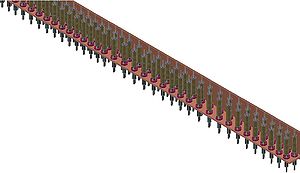Difference between revisions of "Broadband Tagger Hodoscope"
| Line 2: | Line 2: | ||
| − | The coarse fixed-array hodoscope consists of | + | The coarse fixed-array hodoscope consists of 218 scintillators distributed over a length of 9.25 m at a distance of 8 cm (and 13 cm) behind the focal plane of the tagger magnet. |
| − | The high-resolution device ([[Tagger Microscope]]) will be positioned | + | The high-resolution device ([[Tagger Microscope]]) will be positioned on the focal plane. |
| − | The scintillator array detects scattered electrons in the energy range of 0. | + | The scintillator array detects scattered electrons in the energy range of 0.22 to 9.0 GeV (for a 12 GeV electron beam), i.e. it will tag photons between 3.0 GeV and 11.78 GeV. |
| − | The device will primarily be used to | + | The device will primarily be used to |
| − | * measure the energy spectrum during the calibration of the radiator crystals, | + | * measure the energy spectrum during the calibration of the radiator crystals, |
| − | * | + | * monitor the stability of the incoherent photon spectrum during data taking, |
| − | * | + | * tag photons above the coherent peak in order to account for possible beam photon candidates with higher energies than covered by the variable microscope, and |
* act as tagging hodoscope for any experiments (other than GlueX) that require a wide tagged energy coverage or require tagging near the end point. | * act as tagging hodoscope for any experiments (other than GlueX) that require a wide tagged energy coverage or require tagging near the end point. | ||
| − | |||
<table width="100%"> | <table width="100%"> | ||
<tr><td width="50%"> | <tr><td width="50%"> | ||
| − | In order to allow for operating the hodoscope at the projected high rates, only the high-photon-energy range (<i>E<sub>γ</sub></i>>9. | + | In order to allow for operating the hodoscope at the projected high rates, only the high-photon-energy range (<i>E<sub>γ</sub></i>>9.1 GeV) will be fully covered with detectors; the remaining range will be sampled. |
| + | The width of the counters varies between 3 mm and 21 mm to roughly equalize the count rate, i.e. keep the rate at 2-4 MHz per counter at nominal running conditions. | ||
<br> | <br> | ||
| − | All counters | + | All counters are mounted at counter-specific angles such that they face normal to the path of the scattered electrons. |
| − | The construction of the hodoscope allows for later addition of counters to fully cover the | + | The construction of the hodoscope allows for later addition of counters to fully cover the energy range above the coherent peak for other microscope positions by filling the gaps between sampling scintillators. |
| − | + | The mounting frame of the hodoscope is suspended from the Tagger-Hall ceiling to provide full flexibility of microscope positioning. The thin scintillators are slotted into cylindrical light guides which are fastened to mounting plates by a collar.<br> | |
| − | + | ||
| − | <br> | + | |
See [[Specification for broad-band tagging hodoscope]] for details. | See [[Specification for broad-band tagging hodoscope]] for details. | ||
</td> | </td> | ||
<td> | <td> | ||
| − | [[Image:tagger-fixed-array- | + | [[Image:tagger-fixed-array-endpoint.jpg|300px|]] |
</td> | </td> | ||
</tr> | </tr> | ||
Revision as of 17:58, 6 June 2013
The coarse fixed-array hodoscope consists of 218 scintillators distributed over a length of 9.25 m at a distance of 8 cm (and 13 cm) behind the focal plane of the tagger magnet.
The high-resolution device (Tagger Microscope) will be positioned on the focal plane.
The scintillator array detects scattered electrons in the energy range of 0.22 to 9.0 GeV (for a 12 GeV electron beam), i.e. it will tag photons between 3.0 GeV and 11.78 GeV.
The device will primarily be used to
- measure the energy spectrum during the calibration of the radiator crystals,
- monitor the stability of the incoherent photon spectrum during data taking,
- tag photons above the coherent peak in order to account for possible beam photon candidates with higher energies than covered by the variable microscope, and
- act as tagging hodoscope for any experiments (other than GlueX) that require a wide tagged energy coverage or require tagging near the end point.
|
In order to allow for operating the hodoscope at the projected high rates, only the high-photon-energy range (Eγ>9.1 GeV) will be fully covered with detectors; the remaining range will be sampled.
The width of the counters varies between 3 mm and 21 mm to roughly equalize the count rate, i.e. keep the rate at 2-4 MHz per counter at nominal running conditions.
All counters are mounted at counter-specific angles such that they face normal to the path of the scattered electrons.
The construction of the hodoscope allows for later addition of counters to fully cover the energy range above the coherent peak for other microscope positions by filling the gaps between sampling scintillators.
The mounting frame of the hodoscope is suspended from the Tagger-Hall ceiling to provide full flexibility of microscope positioning. The thin scintillators are slotted into cylindrical light guides which are fastened to mounting plates by a collar. See Specification for broad-band tagging hodoscope for details. |
Hodoscope Construction
Hodoscope Fabrication Readiness Review (June 11, 2013)

